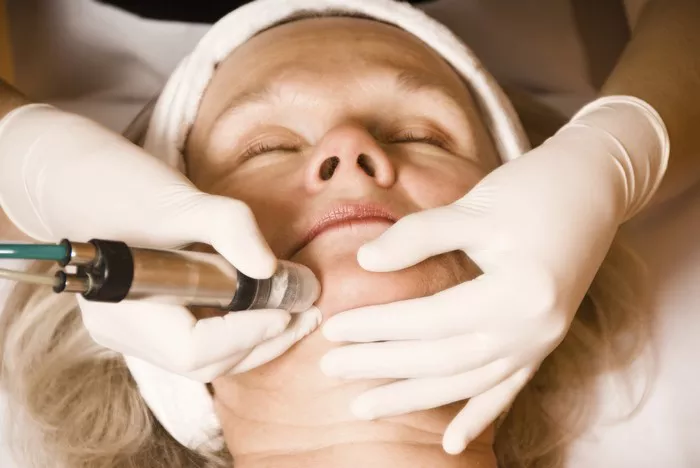Dermabrasion is a cosmetic procedure that involves the use of a specialized tool to remove the top layer of skin. This procedure can help to reduce the appearance of fine lines, wrinkles, acne scars, and other skin imperfections. If you are considering dermabrasion, you may be wondering if the procedure is painful. In this article, we will discuss the pain associated with dermabrasion and what you can expect during and after the procedure.
1. Understanding Dermabrasion
Before we dive into the pain associated with dermabrasion, let’s first understand what the procedure entails. Dermabrasion is a cosmetic procedure that involves the use of a specialized tool to remove the top layer of skin.
The tool used in dermabrasion is typically a small, handheld device that rotates rapidly, abrading the skin’s surface. This process removes the outermost layer of skin, revealing smoother, more youthful-looking skin underneath.
Dermabrasion is typically performed by a dermatologist or plastic surgeon and can be done on various parts of the body, including the face, neck, and hands.
2. Pain During Dermabrasion
During dermabrasion, you may experience some discomfort or pain. The level of pain will depend on several factors, including your pain tolerance, the area of the body being treated, and the type of dermabrasion procedure you are having.
If you are having traditional dermabrasion, which is a more invasive procedure, you may experience more pain than if you are having microdermabrasion, which is a less invasive procedure.
Your dermatologist or plastic surgeon may apply a numbing cream or local anesthesia to the area being treated to help minimize any pain or discomfort. However, you may still feel some pressure or discomfort during the procedure.
3. Pain After Dermabrasion
After dermabrasion, you may experience some pain or discomfort as your skin heals. This can include redness, swelling, and tenderness in the treated area.
Your dermatologist or plastic surgeon may prescribe pain medication or recommend over-the-counter pain relievers to help manage any pain or discomfort you may experience. They may also recommend using a cold compress or ice pack to help reduce swelling and discomfort.
It is important to follow your dermatologist or plastic surgeon’s instructions for caring for your skin after the procedure to minimize any pain or discomfort you may experience.
4. Tips for Minimizing Pain During and After Dermabrasion
Here are some tips for minimizing pain during and after dermabrasion:
Discuss your pain tolerance with your dermatologist or plastic surgeon before the procedure.
Ask about the use of numbing cream or local anesthesia to help minimize pain during the procedure.
Take pain medication or use over-the-counter pain relievers as recommended by your dermatologist or plastic surgeon.
Use a cold compress or ice pack to help reduce swelling and discomfort.
Follow your dermatologist or plastic surgeon’s instructions for caring for your skin after the procedure to minimize any pain or discomfort you may experience.
5. Potential Risks and Side Effects of Dermabrasion
Like any cosmetic procedure, dermabrasion carries some risks and potential side effects. These can include:
Redness and swelling: It is common to experience some redness and swelling after dermabrasion. This should subside within a few days.
Scarring: In rare cases, dermabrasion can lead to scarring. This is more likely to occur with traditional dermabrasion than with microdermabrasion or laser resurfacing.
Infection: There is a small risk of infection with any cosmetic procedure. Be sure to follow your dermatologist or plastic surgeon’s instructions for caring for your skin after the procedure to minimize this risk.
6. Factors That Can Affect Pain During and After Dermabrasion
In addition to the type of dermabrasion procedure you are having, there are several other factors that can affect the pain you experience during and after the procedure. These include:
Your pain tolerance: Everyone experiences pain differently, so your level of pain during and after dermabrasion may be different from someone else’s.
The area of the body being treated: Some areas of the body may be more sensitive than others, which can affect the level of pain you experience during and after dermabrasion.
The depth of the treatment: Deeper treatments may be more painful than more superficial treatments.
Your skin type: Some skin types may be more sensitive than others, which can affect the level of pain you experience during and after dermabrasion.
7. Different Types of Dermabrasion Procedures
There are several different types of dermabrasion procedures, each with their own level of invasiveness and potential for pain. These include:
Microdermabrasion: This is a less invasive type of dermabrasion that uses a small, handheld device to exfoliate the skin. It is typically less painful than traditional dermabrasion.
Chemical peels: This procedure involves the application of a chemical solution to the skin, which causes the top layer of skin to peel off. It can be more painful than microdermabrasion but less painful than traditional dermabrasion.
Laser resurfacing: This procedure uses a laser to remove the top layer of skin. It can be more painful than microdermabrasion or chemical peels but less painful than traditional dermabrasion.
Traditional dermabrasion: This is the most invasive type of dermabrasion, which involves the use of a specialized tool to remove the top layer of skin. It can be more painful than other types of dermabrasion.
8. Conclusion
Dermabrasion is a popular cosmetic procedure that can help to reduce the appearance of fine lines, wrinkles, acne scars, and other skin imperfections. While you may experience some discomfort or pain during and after the procedure, your dermatologist or plastic surgeon can take steps to minimize this.
Be sure to discuss any concerns or questions you have with your dermatologist or plastic surgeon before having the procedure done. With the right approach, dermabrasion can be an effective way to achieve smoother, more youthful-looking skin.

